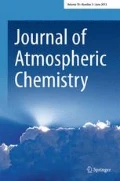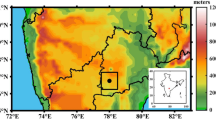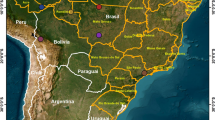Abstract
A Raman lidar system was operated along with the Microtops sunphotometer measurements to carry out the study of the variation of the optical properties of aerosols over Palampur (32.11° N and 76.53° E), India from 17th April to 11th May 2019. The lidar system is furnished with Raman (N2) channel and depolarization channel allowing independent measurement of Lidar Ratio (LR) and linear depolarization ratio. The study reveals that the majority of the aerosols approximately were restricted within the planetary boundary layer (PBL) and very less loading was present in the free troposphere over the study location. The particle loading over the study period was found to be very less with aerosol backscatter coefficient (at 355 nm) ranging from ∼0.13 Mm−1sr−1 to ∼7.25 Mm−1sr−1 with mean value of 2.67 ± 0.82 Mm−1sr−1 and it is well supplemented by the mean aerosol optical depth (AOD) of 0.37 ± 0.13 obtained from Microtops Sunphotometer. The average lidar ratio values for 0-1 km altitude (L1) 72 ± 13sr, for 1-2 km (L2) altitude 55 ± 8sr, for 2-3 km (L3) 54 ± 15sr were observed as suggesting dominance of the biomass burning aerosols and anthropogenic aerosols. The particle depolarization ratio (355 nm) values were found from approximately 4.8 ± 2.7% to 11.5 ± 1.9% with the mean value of 7 ± 1.3% suggesting the presence of non-spherical particles. To trace the sources of the pollution, we derived the HYSPLIT trajectory which shows the majority of the movement was from local sources.












Similar content being viewed by others
Availability of data
Data may be provided as per the Institutional guidelines.
References
Amiridis, V., Balis, D.S., Giannakaki, E., Stohl, A., Kazadzis, S., Koukouli, M.E., Zanis, P.: Optical characteristics of biomass burning aerosols over Southeastern Europe determined from UV-Raman lidar measurements. Atmos. Chem. Phys. 9, 2431–2440 (2009). https://doi.org/10.5194/acp-9-2431-2009
Ansmann, A., Riebesell, M., Weitkamp, C.: Measurement of atmospheric aerosol extinction profiles with a Raman lidar. Opt. Lett. 15, 746 (1990). https://doi.org/10.1364/OL.15.000746
Ansmann, A., Riebesell, M., Wandinger, U., Weitkamp, C., Voss, E., Lahmann, W., Michaelis, W.: Combined raman elastic-backscatter LIDAR for vertical profiling of moisture, aerosol extinction, backscatter, and LIDAR ratio. Appl. Phys. B 55, 18–28 (1992a). https://doi.org/10.1007/BF00348608
Ansmann, A., Wandinger, U., Riebesell, M., Weitkamp, C., Michaelis, W.: Independent measurement of extinction and backscatter profiles in cirrus clouds by using a combined Raman elastic-backscatter lidar. Appl. Opt. 31, 7113–7131 (1992b). https://doi.org/10.1364/AO.31.007113
Ansmann, A.: European pollution outbreaks during ACE 2: Optical particle properties inferred from multiwavelength lidar and star-Sun photometry. J. Geophys. Res. 107, 4259 (2002). https://doi.org/10.1029/2001JD001109
Bangia, T., Omar, A., Sagar, R., Kumar, A., Bhattacharjee, S., Reddy, A., Agarwal, P.K., Kumar, P.: Study of atmospheric aerosols over the central Himalayan region using a newly developed Mie light detection and ranging system: preliminary results. J. Appl. Remote Sens. 5, 053521 (2011)
Behrendt, A., Nakamura, T.: Calculation of the calibration constant of polarization lidar and its dependency on atmospheric temperature. Opt. Express 10, 805–817 (2002)
Charlson, R.J., Schwartz, S.E., Hales, J.M., Cess, R.D., Coakley, J.A., Hansen, J.E., Hofmann, D.J.: Climate Forcing by Anthropogenic Aerosols. Science 255, 423–430 (1992). https://doi.org/10.1126/science.255.5043.423
Donovan, D.P., Whiteway, J.A., Carswell, A.I.: Correction for nonlinear photon-counting effects in lidar systems. Appl. Opt. 32, 6742 (1993). https://doi.org/10.1364/AO.32.006742
Fernald, F.G.: Analysis of atmospheric lidar observations: some comments. Appl. Optic. 23, 652 (1984). https://doi.org/10.1364/AO.23.000652
Freudenthaler, V., Esselborn, M., Wiegner, M., Heese, B., Tesche, M., Ansmann, A., Seefeldner, M.: Depolarization ratio profiling at several wavelengths in pure Saharan dust during SAMUM 2006. Tellus B Chem. Phys. Meteorol. 61(1), 165–179 (2009)
Giannakaki, E., van Zyl, P.G., Müller, D., Balis, D., Komppula, M.: Optical and microphysical characterization of aerosol layers over SouthAfrica by means of multi-wavelength depolarization and Raman lidarmeasurements. Atmos. Chem. Phys. 16, 8109–8123 (2016). https://doi.org/10.5194/acp-16-8109-2016
Groß, S., Tesche, M., Freudenthaler, V., Toledano, C., Wiegner, M., Ansmann, A., Althausen, D., Seefeldner, M.: Characterization of Saharan dust, marine aerosols and mixtures of biomass-burning aerosols and dust by means of multi-wavelength depolarization and Raman lidar measurements during SAMUM 2. Tellus B Chem. Phys. Meteorol. 63, 706–724 (2011). https://doi.org/10.1111/j.1600-0889.2011.00556.x
Hara, Y., Nishizawa, T., Sugimoto, N., Matsui, I., Pan, X., Kobayashi, H., Osada, K., Uno, I.: Optical properties of mixed aerosol layers over Japan derived with multi-wavelength Mie-Raman lidar system. J. Quant. Spectrosc. Radiat. Transfer 188, 20–27 (2017). https://doi.org/10.1016/j.jqsrt.2016.06.038
Hee, W.S., Lim, H.S., Jafri, Mohd.Z.M., Lolli, S., Ying, K.W.,: Vertical Profiling of Aerosol Types Observed across Monsoon Seasons with a Raman Lidar in Penang Island. Malaysia. Aerosol Air Qual. Res. 16, 2843–2854 (2016). https://doi.org/10.4209/aaqr.2015.07.0450
Hegde, P., Pant, P., Bhavani Kumar, Y.: An integrated analysis of lidar observations in association with optical properties of aerosols from a high-altitude location in central Himalayas. Atmosph. Sci. Lett. 10, 48–57 (2009). https://doi.org/10.1002/asl.209
Illingworth, A.J., Barker, H.W., Beljaars, A., Ceccaldi, M., Chepfer, H., Clerbaux, N., Cole, J., Delanoë, J., Domenech, C., Donovan, D.P., Fukuda, S., Hirakata, M., Hogan, R.J., Huenerbein, A., Kollias, P., Kubota, T., Nakajima, T., Nakajima, T.Y., Nishizawa, T., Ohno, Y., Okamoto, H., Oki, R., Sato, K., Satoh, M., Shephard, M.W., Velázquez-Blázquez, A., Wandinger, U., Wehr, T., van Zadelhoff, G.-J.: The EarthCARE satellite: The next step forward in global measurements of clouds, aerosols, precipitation, and radiation. Bull. Am. Meteor. Soc. 96, 1311–1332 (2015). https://doi.org/10.1175/BAMS-D-12-00227.1
Intergovernmental Panel on Climate Change (Ed.): Clouds and aerosols. In Climate Change 2013 - The Physical Science Basis. Cambridge University Press, Cambridge. 571–658 (2014). https://doi.org/10.1017/CBO9781107415324.016
Jaswant, R., S.R., Singh, S.K., Sharma, C., Shukla, D.K.,: Initial assessment of lidar signal and the first result of a Raman lidar installed at a high altitude station in India. Remote Sens. Appl. Soc. Environ. 18, 100309 (2020). https://doi.org/10.1016/j.rsase.2020.100309
Kanitz, T., Engelmann, R., Heinold, B., Baars, H., Skupin, A., Ansmann, A.: Tracking the Saharan Air Layer with shipborne lidar across the tropical Atlantic. Geophys. Res. Lett. 41, 1044–1050 (2014). https://doi.org/10.1002/2013GL058780
Kim, D., Ramanathan, V.: Solar radiation budget and radiative forcing due to aerosols and clouds. J. Geophys. Res. 113, D02203 (2008). https://doi.org/10.1029/2007JD008434
Kumar, S.S., Parameswaran, K., Murthy, B.K.: Lidar observations of cirrus cloud near the tropical tropopause: General features. Atmos. Res. 66(3), 203–227 (2003)
Levy, R.C., Remer, L.A., Mattoo, S., Vermote, E.F., Kaufman, Y.J.: Second‐generation operational algorithm: Retrieval of aerosol properties over land from inversion of Moderate Resolution Imaging Spectroradiometer spectral reflectance. J. Geophys. Res. 112, 2006JD007811 (2007). https://doi.org/10.1029/2006JD007811
Liu, Z., Li, Z., Liu, B., Li, R.: Analysis of saturation signal correction of the troposphere lidar. Chin. Opt. Lett. 7, 1051–1054 (2009)
Mattis, I., Ansmann, A., Müller, D., Wandinger, U., Althausen, D.: Dual-wavelength Raman lidar observations of the extinction-to-backscatter ratio of Saharan dust: Lidar ratios of saharan dust. Geophys. Res. Lett. 29, 20–1–20–4 (2002). https://doi.org/10.1029/2002GL014721
Morys, M., Mims, F.M., Hagerup, S., Anderson, S.E., Baker, A., Kia, J., Walkup, T.: Design, calibration, and performance of MICROTOPS II handheld ozone monitor and Sun photometer. Journal of Geophysical Research: Atmospheres 106(D13), 14573–14582 (2001). https://doi.org/10.1029/2001JD900103
Müller, D., Ansmann, A., Mattis, I., Tesche, M., Wandinger, U., Althausen, D., Pisani, G.: Aerosol-type-dependent lidar ratios observed with Raman lidar. J. Geophys. Res. 112, D16202 (2007). https://doi.org/10.1029/2006JD008292
Radhakrishnan, S.R., Arya, B.C., Sharma, C., Kumar, A., Shukla, D.K.: Studies on lower tropospheric aerosols over New Delhi, India using lidar. Mapan 32, 183–191 (2017). https://doi.org/10.1007/s12647-017-0213-9
Radhakrishnan, S.R., Satyanarayana, M., Krishnakumar, V., Pillai, V.P.M., Reghunath, K.: Lidar measurements on aerosol characteristics at the tropical stations Trivandrum (8.33° N, 77° E) and Gadanki (13.5° N, 79.2° E). In 2009 International Conference on Ultra Modern Telecommunications & Workshops. Presented at the Workshops (ICUMT), IEEE, St. Petersburg, Russia. 1–4 (2009). https://doi.org/10.1109/ICUMT.2009.5345492
Ramana, M.V., Ramanathan, V., Podgorny, I.A., Pradhan, B.B., Shrestha, B.: The direct observations of large aerosol radiative forcing in the Himalayan region. \grl 31, L05111 (2004). https://doi.org/10.1029/2003GL018824
Raymetrics User Manual: LR111-ESS-D200 Raman Depolarization LIDAR. 2016
Sakai, T., Shibata, T., Iwasaka, Y., Nagai, T., Nakazato, M., Matsumura, T., Ichiki, A., Kim, Y.-S., Tamura, K., Troshkin, D., Hamdi, S.: Case study of Raman lidar measurements of Asian dust events in 2000 and 2001 at Nagoya and Tsukuba, Japan. Atmos. Environ. 36, 5479–5489 (2002). https://doi.org/10.1016/S1352-2310(02)00664-7
Sasano, Y., Browell, E.V., Ismail, S.: Error caused by using a constant extinction/backscattering ratio in the lidar solution. Appl. Opt. 24(22), 3929–3932 (1985)
Satheesh, S.K., Moorthy, K.K., Babu, S.S., Vinoj, V., Dutt, C.B.S.: Climate implications of large warming by elevated aerosol over India. Geophys. Res. Lett. 35, L19809 (2008). https://doi.org/10.1029/2008GL034944
Solanki, R., Singh, N.: LiDAR observations of the vertical distribution of aerosols in free troposphere: Comparison with CALIPSO level-2 data over the central Himalayas. Atmos. Environ. 99, 227–238 (2014). https://doi.org/10.1016/j.atmosenv.2014.09.083
Srivastava, A.K., Pant, P., Hegde, P., Singh, S., Dumka, U.C., Naja, M., Singh, N., Bhavanikumar, Y.: The influence of a south Asian dust storm on aerosol radiative forcing at a high-altitude station in central Himalayas. Int. J. Remote Sens. 32, 7827–7845 (2011). https://doi.org/10.1080/01431161.2010.531781
Tesche, M., Gross, S., Ansmann, A., Müller, D., Althausen, D., Freudenthaler, V., Esselborn, M.: Profiling of Saharan dust and biomass-burning smoke with multiwavelength polarization Raman lidar at Cape Verde. Tellus B Chem. Phys. Meteorol. 63, 649–676 (2011). https://doi.org/10.1111/j.1600-0889.2011.00548.x
Tiwari, S., Singh, A.K.: Variability of aerosol parameters derived from ground and satellite measurements over varanasi located in the indo-gangetic basin. Aerosol Air Qual. Res. 13, 627–638 (2013). https://doi.org/10.4209/aaqr.2012.06.0162
Acknowledgements
Authors are grateful to Director, CSIR- National Physical Laboratory for necessary support. Authors are thankful to CSIR network project PSC-0112 for necessary financial support. Mr. Shishir Kumar Singh is thankful to University Grant Commission (UGC) for providing research fellowship and also to Academy of Scientific and Innovative Research (AcSIR) for facilitating as its PhD student.
Funding
Council of Scientific and Industrial Research (CSIR), India.
Author information
Authors and Affiliations
Corresponding author
Ethics declarations
Conflict of interest
We have no conflict of interest to disclose.
Additional information
Publisher's note
Springer Nature remains neutral with regard to jurisdictional claims in published maps and institutional affiliations.
Supplementary information
Below is the link to the electronic supplementary material.
Rights and permissions
About this article
Cite this article
Singh, S.K., Radhakrishnan, S.R., Jaswant et al. Study of variation of aerosol optical properties over a high altitude station in Indian Western Himalayan region, palampur using raman lidar system. J Atmos Chem 79, 117–139 (2022). https://doi.org/10.1007/s10874-022-09432-5
Received:
Accepted:
Published:
Issue Date:
DOI: https://doi.org/10.1007/s10874-022-09432-5




